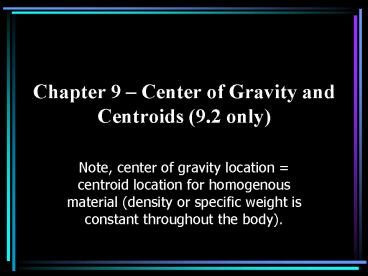Chapter 9 PowerPoint PPT Presentation
1 / 24
Title: Chapter 9
1
Chapter 9 Center of Gravity and Centroids (9.2
only)
- Note, center of gravity location centroid
location for homogenous material (density or
specific weight is constant throughout the body).
2
APPLICATIONS (continued)
One of the important factors in determining its
stability is the SUVs center of mass.
Should it be higher or lower to make a SUV more
stable?
How do you determine the location of the SUVs
center of mass?
3
APPLICATIONS (continued)
Integration must be used to determine total
weight of the goal post due to the curvature of
the supporting member.
How do you determine the location of its center
of gravity?
4
CONCEPT OF CENTER OF GRAVITY (CG)
A body is composed of an infinite number
of particles, and so if the body is located
within a gravitational field, then each of these
particles will have a weight dW.
The center of gravity (CG) is a point, often
shown as G, which locates the resultant weight of
a system of particles or a solid body.
From the definition of a resultant force, the sum
of moments due to individual particle weighst
about any point is the same as the moment due to
the resultant weight located at G.
Also, note that the sum of moments due to the
individual particles weights about point G is
equal to zero.
5
CONCEPT OF CG (continued)
6
CONCEPT OF CENTROID
The centroid, C, is a point which defines the
geometric center of an object.
The centroid coincides with the center of mass or
the center of gravity only if the material of the
body is homogenous (density or specific weight is
constant throughout the body).
If an object has an axis of symmetry, then the
centroid of object lies on that axis.
In some cases, the centroid is not located on the
object (u-shape).
Equations
x ( ?A x dA ) / ( ?A dA )
y ( ?A y dA ) / ( ?A dA )
7
Centroids of Common Areas
Note Centroid CG for homogenous body!!!
8
Centroids of Common Areas
9
COMPOSITE BODIES
How can we easily determine the location of the
centroid for a given beam shape?
10
CONCEPT OF A COMPOSITE BODY
Knowing the location of the centroid, C, or
center of gravity, G, of the simple shaped parts,
we can easily determine the location of the C or
G for the more complex composite body.
11
CONCEPT OF A COMPOSITE BODY (continued)
12
STEPS FOR ANALYSIS
1. Divide the body into pieces that are known
shapes. Holes are considered as
pieces with negative weight or size.
2. Make a table with the first column for segment
number, the second column for weight, mass, or
size (depending on the problem), the next set of
columns for the moment arms, and, finally,
several columns for recording results of simple
intermediate calculations.
3. Fix the coordinate axes, determine the
coordinates of the center of gravity of centroid
of each piece, and then fill in the table.
13
EXAMPLE
Solution 1. This body can be divided into the
following pieces rectangle (a) triangle
(b) quarter circular (c) semicircular area
(d). Note the negative sign on the hole!
14
EXAMPLE (continued)
15
EXAMPLE (continued)
16
CONCEPT QUIZ
1. Based on the typical centroid information,
what are the minimum number of pieces you will
have to consider for determining the centroid of
the area shown at the right? A) 1 B) 2
C) 3 D) 4
2. A storage box is tilted up to clean the rug
underneath the box. It is tilted up by pulling
the handle C, with edge A remaining on the
ground. What is the maximum angle of tilt
(measured between bottom AB and the ground)
possible before the box tips over? A) 30 B)
45 C) 60 D) 90
17
Examples Find Centroids for these cross-sections
Side, CG?
18
Centroid of Composite Areas
- Missing Areas can be calculated into the Centroid
by analyzing it as a negative area.
19
Sample Problem - Hole
20
Sample Problem - Hole
- Compute the coordinates of the area centroid by
dividing the first moments by the total area.
21
CG / CM OF A COMPOSITE BODY
By replacing the W with a M in these equations,
the coordinates of the center of mass can be
found.
22
Example Center of Gravity, 3D with different
densities
Solution 1. In this problem, the blocks A and B
can be considered as two pieces (or segments).
23
GROUP PROBLEM SOLVING (continued)
24
GROUP PROBLEM SOLVING (continued)
Table Summary
Substituting into the equations

